| AstroNuclPhysics ® Nuclear Physics - Astrophysics - Cosmology | ||||
 |
TIME TRAVEL
Vojtech
Ullmann A
popular-scientific lecture on the unusual properties of
space time and on the exciting possibilities of |
|||
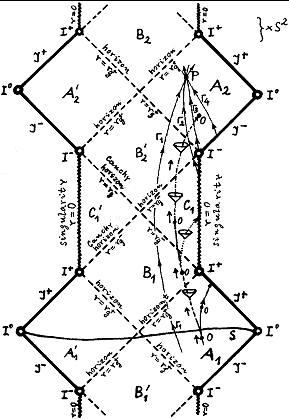 |
||||
| AstroNuclPhysics ® Nuclear Physics - Astrophysics - Cosmology | ||||
 |
TIME TRAVEL
Vojtech
Ullmann A
popular-scientific lecture on the unusual properties of
space time and on the exciting possibilities of |
|||
 |
||||
S y l a b u s
(a more detailed
physical and mathematical analysis is in the book " Gravity,
Black Holes and the Physics of Spacetime ")
INTRODUCTION
Time travel is a fascinating
theme that smells of mysticism, adventure, the deepest secrets of
the existence of the universe and our life and destiny.
| What is so appealing about "time travel" for us ? |
| è Overcoming death, dreams of eternal
youth è Revision of wrong decisions in the past è Predicting the consequences of our decisions in the future è Reversing adversity, averting disasters, wars è Meeting deceased ancestors, averting their death è Reliving the beautiful moments of the past (some of which now it can no longer be repeated due to illness or old age) è Naturalists - get to know what new knowledge will appear in the future è Historians - to know how distant historical events really happened è ... etc. |
History -
Literature sci-fi :
H.G.Wells: "Time
Machine" (1895) - in contradiction with previous
notions of absolute time
Jakub Arbes: "Newton's brain" - it's
not time travel, it's just a glimpse into the past
Common feature: superluminal
speed
Pitfalls of time travel (discussed in more detail below) :
Within Newtonian physics, due
to its concept of absolute
time, "time travel" was
completely impossible.
It was only in the context of a special theory of
relativity, enabling the speed of time to be influenced
by motion, or a general theory of relativity
showing the influence of gravity on the course of time, that time
travel began to be considered in a sense a physically real possibility .
WHAT IS IT TIME ?
Actually, we do not know ..?! .. We can
only say:
Time is a" something "
that determines the sequence of events makes it
possible to compare the duration of events and
the intervals between them, to quantify the motions
of objects and dynamic changes in the physical,
chemical and biological systems.
This is not a definition, it would be a tautology (definition in a circle) .
The secret of time is more than 1000 years old. E.g. and 4th
century Aurelius Augustinus declared :
" If no one asks me, I know what time means. But if I
have to explain it to someone, I find that I don't know!
"
Time measurement -
chronology
Regular events (consistent and predictable) and periodic
movements are the most suitable standards for measuring
time. In everyday life, such periodic events are the movement of
the Sun across the sky (in fact, it is the rotation of the
Earth), the phases of the Moon, the alternation of seasons (the
Earth's orbit around the Sun), the pendulum swing, the vibration
of the spring. From these observed natural laws the time units
year, month, day, hour, minute, second were derived. For
historical reasons, there is no decimal recalculation, but
factors 12 and 60 are used (unfortunately
it was not possible to reform) . However,
the natural cycles from which the original units of time were
derived are not completely regular, which required a new
determination for more accurate measurements:
Unit of time in the SI system - second. Current
definition: 1 second is the duration of 9 192 631 770 periods of
radiation emitted during the transition between two hyperfine
levels in the ground state of the cesium-133 atom - "Atomic
Clock"
Chronology, study of the past
:
- history, archeology (tens, hundreds, thousands
of years) ;
- geochronology (hundreds of thousands,
millions, billions of years) ;
- the time evolution of the universe (billions
of years and more) .
Physical conception of space and time :
| Theory of relativity : |
| "Time is what the clock
shows "
ß "ideal" clock - isolated or corrected for all non-universal influences resp. : " Time is one of the coordinates of 4-dimensional space-time " This time also coincides with "biological" time! |
Note: Of course, time shifts of a few hours when traveling by plane, for example between Europe and America, have nothing to do with time travel. Here, this is only related to the rapid flight between the agreed time zones, which are the result of our measurement of time of day by rotating the Earth around the axis. We will not move in time, but only in marking the time with agreed numerical hours - day clocks, which are shifted according to longitude.
TIME
ARROW
What determines the direction of the passage of time ?
More detailed discussion: §5.6 " The future of the universe. The arrow of time. Dark matter. " (in the book "Gravity, Black Holes and the Physics of Spacetime").
Time
travel
Within Newtonian physics, due to its concept of absolute time, "time travel" is completely impossible.
Only within the special theory of relativity,
which allows influencing the speed of time flow by motion, or the
general theory of relativity showing the
influence of gravity on the course of time, can time travel be
considered in a sense a physically
real possibility .
SPECIAL THEORY OF RELATIVITY (STR)
ß
- time travel only to the future -
Special theory of relativity (more detailed explanation of §1.6 "Four- dimensional spacetime and special theory of relativity ") :
| 1. Galilei- Eistein's special principle of relativity : |
| The laws of physics are the same for all inertial frames of reference |
2. Principle of constant speed of light : |
| The speed of light in vacuum is the same in all inertial systems regardless of any movement of the source or observer |
Principle of relativity
+ Principle of constant speed of light Þ Lorentz
transformations
ß ß
high speed Þ time dilation , length contraction
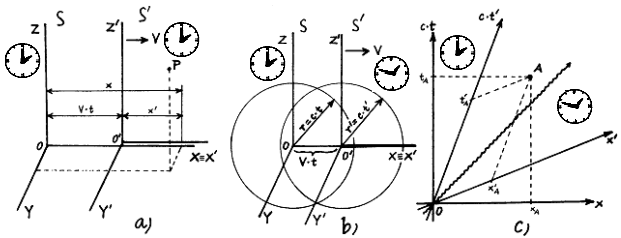 |
The interval of the proper
time dt = Ö (1-v2/c2) .dt of a moving body is always smaller than the corresponding coordinate time interval. An observer comparing the movement of the rest and moving clocks finds that the moving clocks go according to the relation (1.70) the slower the faster they move; This phenomenon is called relativistic dilatation time . |
Lorentz
transformations :

D t '= D t / Ö (1 - v 2 / c 2 ) -
time dilation
! The
biological time also takes place in the same rhythm - the aging
of cells in the organism !

Spacetime
diagram - light cone, causality in spacetime
Spacetime interval - invariant
s 2 º x 2 + y 2 + z 2 - c2 .t 2
"Time is one of the coordinates of 4-dimensional (pseudo)
Euclidean spacetime"
"Mixing" of space and time in different inertial frames of reference, relativity of the present .
Time
travel to the future
:
Relativistic time dilation
in STR:
For the observer moving at high speed close to the speed of light
passes time slower than the reference
"rest" observer, so that even a large time interval in
the rest frame can bridge a much shorter time interval, ie.
" travel to the future " of the rest
reference system.
The paradox
of time - twins - solved within STR, it
is not necessary to use the general theory of relativity :
Time is delayed by the observer whose motion takes place in two
frames of reference (inertial or non-inertial).
Note: In the popularization literature,
it is often argued that the general theory of relativity must be
used to solve the twin paradox, because the traveler's frame of
reference is non-inertial - that the time difference arises in
the phase of braking and reversing the second observer's motion.
This statement is misleading and unconvincing;
in fact, the twin paradox can be correctly solved within the
special theory of relativity itself using three
inertial frames of reference: the rest systems of the first
observer and the two different moving systems of
the second observer as they move back and forth.
Detailed analysis: §1.6 "Four- dimensional spacetime
and special theory of relativity ", passage "The
paradox of time".
Time
travel into the past
:
Kinematic effects of the theory of relativity offer - at least
formally - three possibilities of time travel into the past :
=> In
flat spacetime STR by moving superluminal speed
(pictured left);
=> In
the curved spacetime of the general theory of relativity by
moving at a locally sublight speed
within a sequence of suitably inclined light cones
in an area with a strongly curved geometry of spacetime (pictured
right) - will be discussed below.

=> Another
hypothetical possibility is the complex topological
structure of spacetime - "abbreviations,
tunnels, wormholes" (discussed below) .
The need to exceed the speed of light - STR forbids !
Although: tachyons
- particles faster than light?
Tachyons are purely speculative particles that can move only at superluminal
velocities and have (in connection with the known
relationship of mass versus velocity m = mo /Ö(1-v2/c2) in the special theory of relativity) an imaginary
mass. The motivation for the introduction of tachyons is
only speculation about a kind of symmetry with respect to the
speed of light, no physical arguments for them; rather, they
would raise serious problems with the principle of
causality .
In reality, therefore, only the solution within the general theory of relativity remains for travel into the past :
GENERAL THEORY OF RELATIVITY
- physics of gravity and curved spacetime -
ß
- in the principle of time travel to
the future and to the past -
Universality of gravity Þ principle of equivalence:
| The gravitational field at each point is locally equivalent (for all physical processes) to a situation where there is no gravitational field, but the reference system (observer) at this point moves with the appropriate acceleration - it is non-inertial. |
ß
Gravity = curved spacetime
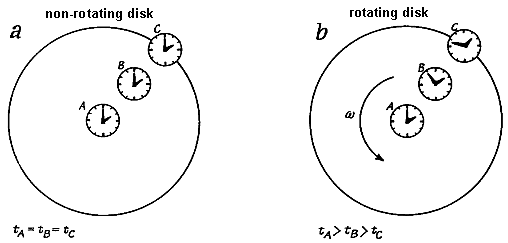
Gravity - inertia - kinematics - deceleration
of time
| Einstein's equations of gravitational field (without cosmological term) : |
|
Rik - Ricci spacetime curvature tensor, gik - metric spacetime tensor, G - Newton's
gravitational constant, c - speed of light, Tik - energy-momentum tensor; Gik - Einstein's curvature tensor
spacetime interval: ds2 = gik dxi dxk ; geodesic equation: ![]()
Christoffel coefficients of an affine connection: Gkil = (1/2) gim (¶gmk/¶xl + ¶gml/¶xk
+ ¶gkl/¶xm)
Curvature of spacetime : 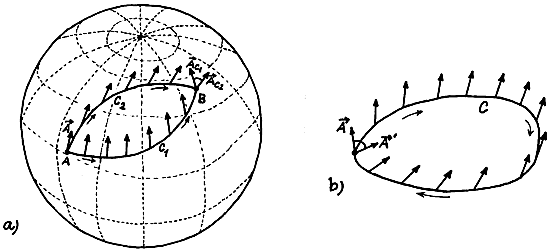
Curvature tensor :
The energy-momentum tensor, which completely describes the distribution and motion of energy and momentum in a given physical system, generally has a structure (§1.6, section " Energy-momentum tensor ") :
| T ik = | / | energy density |
energy current density, |
\ | |||
| | | | | ||||||
| | | energy current density, |
momentum
current density, |
| | ||||
| \ | / | ||||||
The physical significance of the individual components of the energy-momentum tensor T i is thus as follows:
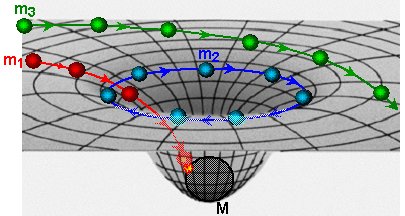
The gravitational body M curves spacetime in its vicinity
The dialectic of the
general theory of relativity :
Matter
dictates spacetime as it should curve ;
(curved) Spacetime dictates matter how it should
move .
(more detailed explanation "General
theory of relativity - physics of gravitation" - in the book "Gravity,
Black Holes and the Physics of Spacetime" )
Time
travel to the future:
Gravitational time dilation
:
The actual time with
respect to the coordinate time (which
corresponds to the zero gravitational potential) flows the slower , the higher the value of the
gravitational potential j at a given location (gravitational potential is negative) :
dt = (dx°/c).Ö(1 + 2j/c2) » (1 + j/c2) dt
.
The clock located in
the gravitational field is delayed relative to the same clock located
outside the field (or in a place with a weaker field).
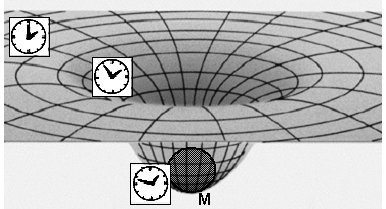 |
Gravitational
dilation of time. The clock located in the gravitational field is delayed compared to the same clock located outside the field (or in a place with a weaker field). |
It is enough for the observer to stay long enough in a place with strong gravity (high gravitational potential), where time passes more slowly, to return to the starting point at a time when a much larger interval of time has passed in the meantime.
Time
travel into the past
:
The geometry of curved spacetime of
general relativity offers two possibilities of time travel into
the past :
=> By
moving at a locally sublight speed
within a sequence suitably inclined light cones
in an area with a strongly curved space-time geometry - in the
picture on the right î

=> Another
hypothetical possibility is the complex
geometric-topological structure of spacetime .
Gravity affects both the passage of time and spatial scales
and proportions. In such a globally curved spacetime, there may
be some "shortcuts" over spacetime - geometric-topological
"tunnels" that allow the observer to
in a sense "overtake" the light beam and
"travel" back to the past. At the same time, locally
everything runs according to STR, the speed of light is not
exceeded anywhere.
It's similar to the fact that a sailor sailing here on Earth
across the ocean, still facing forward, may eventually find that
he has returned to the place from which he sailed. Moving in
curved spacetime, the observer can, in principle, find out over
time that he has not only reached the starting point, but that he
has "visited" an event from his past again, even though
locally his time has flowed towards the future.
Are "time machines" physically possible ?
Black holes - bridges to other
universes? Time machines? ï click
Black holes:
1. Large black holes - final stages of evolution of massive stars
after gravitational collapse, giant black holes in the center of
galaxies (quasars);
2. Black "microholes" - primordial, formed at the
beginning of the universe during big-bang.
Spacetime singularities: Apparent (coordinate)-
removable; Real (physical) - irremovable.
Rotating black holes - Kerr-Newman geometry, ring singularity ;
Naked singularities (R.Penrose:The principle of cosmic censorship- every singularity must be "dressed" to the
horizon) ;
Analytical extension of black
hole spacetime ®
tunnels to other universes
- or to other places in the same universe ?
| Schwarzschild geometry of a centrally symmetric non-rotating black hole : | ||||
 |
 |
|||
| Kruskal's spacetime diagram of the
analytical extension of Schwarzschild geometry. a) Coordinate network in relation to the Schwarzschild coordinates r and t . b) Overall structure of spacetime and motion of test particles and photons. A is the outer asymptotically planar region, B is the inner region below the horizon. |
Penrose-Kruskal
conformal space-time diagram of the complete extension of
Schwarzschild geometry. a) Coordinate lines in relation to the Schwarzschild coordinates (hyperplanes r = const. and t = const.). b) Shapes of light cones and radial geodesics of time and light type. |
|||
 a) Einstein-Rosen bridge between two universes. b) Topological tunnel between two places in space. c) "Wormhole" connecting two places in one universe. |
||||
| The analytical extension of Schwarzschild's geometry contains two asymptotically planar regions - two "universes", between which the Einstein-Rosen bridge can form for a short time. However, it disappears very quickly - it is impassable, not even a light photon penetrates it ! | ||||
Rotating
gravity
The only known physically real possibility of
such a deformation of spacetime in which there would be a
suitable rotation of spacetime light cones is rotating gravity :
entrainment (drift, towing) of local
inertial systems by the rotational angular momentum
of the source matter, that excited the gravitational field - Lense-Thirring
effect - §2.5, passage "Rotating
gravity". Another hypothetical possibility - "electrogravity"
using an extremely strong electric charge, is mentioned below.
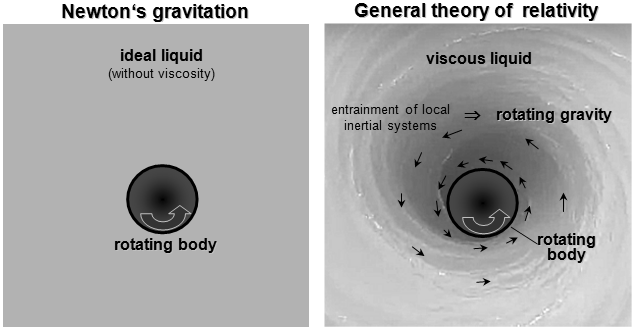 |
Hydrodynamic analogy of the
influence of the rotation of the source body on the
properties of the excited gravitational field. Left: In Newton's theory, the gravitational field of
a body is given only by the distribution of matter and
does not depend at all on its possible rotation (unless
it leads to changes in the distribution of matter). Similarly,
a smooth and symmetrical body (such as a sphere) rotating
in an ideal liquid without viscosity does not cause the
liquid to move around it. Right: In general relativity, but rotation of the source, leaving the outer gravitational field (on spacetime metric) characteristic "tracks" - leads to entrainment of local inertial system (frame dragging) - entrainment of free bodies by a rotating gravitational field in the direction of rotation of the source. Like a body rotating in a viscous liquid, it entrains the liquid near its surface. |
The rotational momentum J
of the source system (has components Ja= neabgxbTg0d3x),
described by non-diagonal components of the energy-momentum
tensor, leads in the solution of Einstein's equations to
non-diagonal terms in the metric tensor (4GJ/c2r).sin2J dt dj; metric is then :
![]()
a Schwarzschild metric ä "rotation"
metric
These off-diagonal members dj.dt
lead to the fact that that a certain additional force acts on the
bodies (in the geodesic equation d2j/dt2 ¹ 0 becomes non-zero) causing entrainment of local inertial systems (frame dragging) - entrainment of free bodies by a rotating
gravitational field in the
direction of rotation of the source .
| Kerr-Newman geometry of rotating axially symmetric black holes : | ||
 a = J / M - specific angular momentum, Q - electr. charge |
||
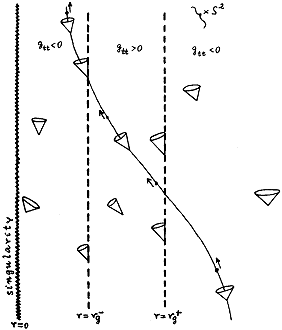 Spatio-temporal diagram of Kerr-Newman geometry - §3.6). The outer horizon r = rg+ is the event horizon (the light cones below it face inwards towards r = 0). Below the inner horizon r = rg- , however, the light cones begin to "straighten" again, so that the light line of a body that has penetrated below the horizon r = rg+ does not necessarily end in the singularity r = 0. |
 Full analytical extension |
The O
observer moving in the outer
asymptotically plane region of the A1 Kerr-Newman spacetime has three
possibilities. It will either move constantly in A1 (solid line), so it will reach infinities I+ or Á+ in the limit. However , if the observer penetrates below the horizon r = rg+ (dashed trajectory) into the inner region B1, he also passes through the inner horizon r = rg- into the region C1, where he has two possibilities: he either encounters singularity (dotted path) where it is absorbed and destroyed, or it can avoid singularity (dashed trajectory) and reach another asymptotically planar outer region A2 . The situation in this next "universe" A2 is not completely determined by the initial conditions on the Cauchy hyperfield S , as can be seen, for example, at the point pÎA2 . |
Critical assessment
- what is the reality ?
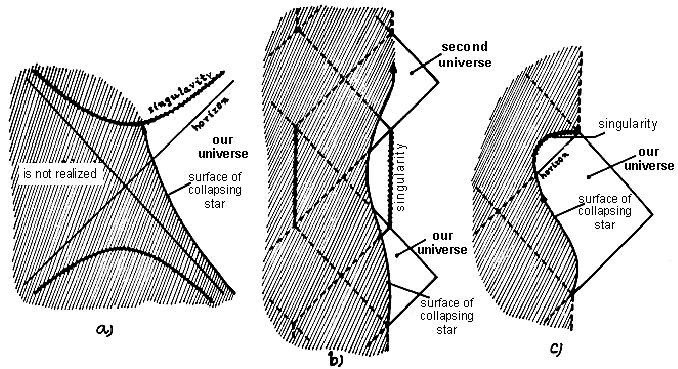
The space-time structure of a real black hole.
a) In
Schwarzschild's spacetime of a static black hole created by the
collapse of a (non-rotating) star, a large part of the structure
of the Kruskal's diagram is cut off by interior of the the collapsing star. b)
The collapse of a
rotating star into a black hole could theoretically
create a space-time
structure allowing it to travel to another
universe. The collapsing
matter could then emerge in the second universe in the form of a
"white hole". c) However, due to the diverging intensity of
the incoming radiation at the inner horizon and the quantum
production of particles around the singularity, much of the
theoretical structure of Kerrr-Newman geometry (including inner
horizons and other universes on the Penrose diagram)
actually cannot be realized. The collapse creates a singularity
that is in the future and
takes on a spatial character, which does
not allow any travel to other universes .
Thought model experiment: Tipler's massive infinitely long relativistically rotating cylinder
 |
A thin, infinitely long supermassive
(tens of masses of the Sun) and a super-dense cylinder,
rotating at a tremendous speed (of the order of billions
of revolutions per second, circumferential speed > c/2). At great distances from the cylinder (in asymptotically planar spacetime), the light cones will point vertically upwards (along the time axis), so that the sublight speed allows the body to move only in the positive time direction + t (enlarged section in the figure on the left). There is a strong curvature of space-time near the massively gravitational cylinder, and due to the effect of entrainment of local inertial systems by the momentum of the cylinder (Lense-Thirring effect) the light cones will be inclined by more than 45°, so that part of them points backwards along the time axis on the space-time diagram. Within these entrained light cones, the helical path (light line) of the particle can move at a sublight speed both into the future and into the past - in the negative direction - t . |
Problem: Requires the infinitely long cylinder. Implementation with a finite length of cylinder would be possible only with the violation of a weak energy condition - the need for "exotic matter" with a negative energy density in the Cauchy horizon - see below.
Electrogravity
Another hypothetical possibility is the application of an
extremely strong electric field. Einstein's gravitational
equations using the energy-momentum tensor of the electric field
lead to the Reissner-Nordström geometry of spacetime
, containing an inner horizon and a topological tunnel
to other universes. From the quantum point of view, the
Casimir effect between parallel superconducting plates,
caused by quantum electromagnetic fluctuations of the vacuum, is
considered. .....
Next - artificial solutions ...: Gödel's rotating universe; cosmic strings; warp (Alcubierr) propulsion - pure sci-fi ...
Cosmic strings - hypothetical 1-dimensional topological defects in space-time, which perhaps could have occurred during the Big Bang and due to the expansion of space (especially inflation) could be expanded to macroscopic to cosmic dimensions *). According to some, a combination of two moving cosmic strings, or strings + black holes, would make it possible to create closed time curves and tunnels that would allow travel to different places and times. *) Although there is no direct connection between cosmic strings and superstrings in unitary field theories, according to some hypotheses, cosmic strings could be inflation-expanded D-gates from superstring theory ..?..
| Warp
drive - a speculative image of a special "bubble" of curved space, which propagates like a wave through flat space and inside it, the observer can travel locally at sublight, but globally at super-light speed. M. Alcubierre constructed a special space-time metric that could model such a curvature. Formal substitution into Einstein gravit. equations, it was found that to possibly the realization would require exotic matter, tachyons or a naked singularity - probably unrealizable ... |
 |
Wormholes

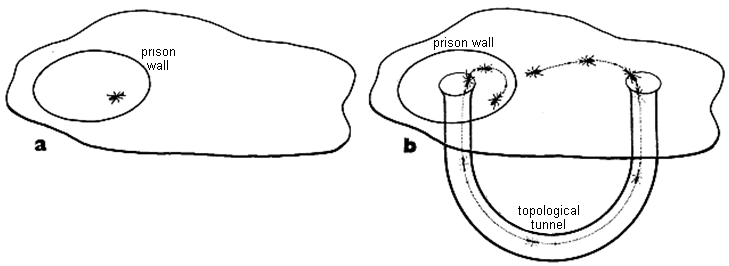
Wormhole = tunnel connecting different
places in space-time 
® Hypothetical abbreviation for traveling between
distant places in space, or for traveling between places in other
universes (otherwise separated) .
Wormholes : permeable ( traversible
) ,
impermeable ( non-traversible
)
Possibilities
of using wormholes for time travel :
It is necessary to achieve a violation of time synchronization between the two mouths of wormholes. Theoretically,
this can be done in basically two ways:
c Movement of the mouths of traversible
wormholes ® Different
relativistic time dilation ®can be
used for time travel .
c "Park" one mouth of a wormhole in a place with
a high gravitational potential ® gravitational
dilation of time ...
One end of the wormhole would end up on Earth and the other near
the horizon of the black hole. If we enter its initial opening
and then travel towards the black hole, then time will begin to
flow much slower than when entering. Only a few hours pass in the
hole at the horizon of the black hole, while many years may pass
in the entrance hole on Earth. In this way, traveling the
wormhole "here and there" gives us a hypothetical
opportunity to look into the distant future or past... If we
wanted to achieve large time differences, the second mouth of the
wormhole would have to be located close to the horizon of the
black hole. Then, however, there would be a problem of leaving
them without being irreversibly drawn into a black hole..!..
Another problem with the instability and explosion of a wormhole
is mentioned below.
Wormholes :
× Microscopic -
quantum - arise everywhere and
constantly due to quantum fluctuations in the geometry and
topology of spacetime:

 "Topological foam"
"Topological foam"
× Macroscopic - cosmic Inflationary expansion of the universe cmicroscopic
wormhole can expand to macro- or mega-dimensions..?..
.. Next: ?? Artificially
created wormholes ?? - Sci-Fi ..?!..
Problem: Instability of wormholes -
strangulation, the conversion of a black hole is a singularity ®Nextinction of a wormholeN.
To ensure stability of wormholes is needed of
"reinforcement" field using the negative energy
density:®"exotic
field", "exotic material"
or "exotic mater" (Kip Thorne).
Violation weak energy conditions or energy dominance
(§2.6 "Deviation
and focus of geodesics") .
(Tik - 1/2 T gik ) Vi
Vk l 0 ®
r l 0 , r + pa l 0 - weak
energy condition
TikViVk l 0
and vector TikVk is the time or isotropic type ® r ³ 0 , -r £ pa £ r (a = 1,2,3) - energy
dominance
(local energy density is non-negative and
in addition the local energy flow takes place only inside or on
the mantle of the light cone) -
energy "dominates" over other components of
the energy-momentum tensor ; -
the pressure does not exceed the energy
density, the speed
of "sound" does not exceed the speed of light.
According to Raychaudhuri's equation
of deviation and focusing of geodesics :
When the energy conditions (inequalities) for the energy-momentum
tensor are met, gravity has an attractive character and on geodesics of time
resp. isotropic type focusing effect .
On the contrary: The wormhole needs
"exotic matter" with a negative energy density -
antigravity !!
Exotic matter
Matter with special, rare occurrences - " exotic
" - properties.
How "exotic" would a mass with a negative energy
density have to be to reinforce topological tunnels acting as
time machines? ...
She is crazy
exotic! - above all our imagination ..!..
Any exotic substance that has been created on the largest
accelerators is "ordinary" in this respect ..!..

Nuclear reactions in collisions of two heavy atomic nuclei.
Above: When two nuclei collide at low or medium
energies, their electrical (Coulombic) scattering, inelastic
scattering with direct interactions by nucleon transfer or
ejection, fragmentation or composition (fusion) of the nuclei can
occur to form a new heavy nucleus.
Bottom: In a high-energy collision of
two nuclei for a brief moment of 10-20 sec. a quark-gluon
plasma is formed, followed by hadronization.
However, we may have exotic
matter with a negative energy density all around: DARK ENERGY î

Different possibilities for the dynamics of the evolution of the
universe. a) Closed space. b)
Open space. c) Open space with final accelerated
expansion - is caused by dark energy with
antigravity effects.
Quantum fluctuations - by the uncertainty principle of quantum DE.Dt ³ h can briefly "swing" the local energy density to negative values. However, accumulating extremely dilute dark energy in the universe, or extracting negative micro-quantum fluctuations, into macroscopic scales is completely sci-fi ..!..
Another sci-fi option: ?? Develop and uncover hidden compacted extra-dimensions of the Calabi-Yau manifold in multidimensional superstring theories ?? ...?... thus we could get into a completely different reality with other physical laws ...?!... - different kinds of interactions ..?.. ® N
The physics of black holes is discussed in
detail in Chapter 4 "Black Holes" of the book "Gravity,
Black Holes and the Physics of Spacetime".
On our topic: "Black holes - bridges to other
universes? Time machines?".
In the same monograph, see also: §3.3, section "Closed
worldlines and time travel" .
Time travel
to the past
ß
- ? logical
paradoxes and disputes with the principle of causality ? -
| The existence of closed time-lines of world leads to logical paradoxes : |
| On the way to the past,
there can be situations and events, when the result cancels the cause that caused it (reaction cancels the action that triggered it) |
The paradox of the murder of our ancestors (the paradox of maternal murder, grandfather murder,
etc.) :
After a closed time world, we could go back in time and kill our
own parents (or grandparents) before his
own birth.
Or a less morbid situation :
| The Astronaut Paradox - A prevented start and a space flight | |
 |
The astronaut launches into space in a rocket and flies into the mouth of a "wormhole", which acts as a "time machine". After a closed time world-line, he could then return in space and time to his launch, damage the rocket and prevent himself from this original launch . |
What it would then be
possible to reconcile the two controversial
alternatives
in the future: our existence, when we could not be born ?; or the
flight of an astronaut in a rocket, when he prevented himself from
taking off ? Thus, such a traveler could not even go
back to the past and perform the mentioned interventions ..!? ..
Monograph "Gravity, Black Holes and
the Physics of Spacetime", §3.3, section "Closed World Lines and Time Travel".
1. Possible solution: Self-consistent
synchronization - negation
of "freedom of will"
Logical paradoxes and disputes with the principle of causality in
time travel typically arise under the assumption of " freedom of will " - that the competent entity can
decide in principle any intervention in running events. If
freedom of will did not exist (and there really is no such thing
in classical physics), there would not
have to be
a dispute with the principle of causality: the traveler does not
change the past over time, because he has always been an immanent
part of it (he can fulfill the past, not change it). The universe
can be imagined as a "finished" and unique
4-dimensional manifold, into which the individual worldlines are
already "incorporated". From this perspective, all
events on time closed world lines could already
be "synchronized"
so that they interacted without
contradiction in a
closed cycle - would be self-consistent .
Objection:
However, if we take into account the irreversibility of the
evolution of the universe (existence of dissipative processes,
2nd law of thermodynamics), the existence of closed time curves
is physically unlikely, because the situation at
a later time t2 cannot
be identical with the situation at an earlier time t1. Thus, closed curves leading to
a "time machine" could perhaps function at most within elementary
particles .
Key objection: "billiard ball paradox" :
| The paradox of billiard balls - conflicting trajectories of bodies | |
 |
From a starting
position, by tapping of cue, a billiard ball is sent at a
suitable speed towards the right mouth of the wormhole,
functioning as a "time machine" - along a path A.
This sphere flies through a wormhole, goes back in time
and flies out of the left mouth before it has flown into
trajectory A into the right mouth. It can then
crash "into itself" (into
its "younger version"),
divert path A to an alternative trajectory B,
out of the wormhole. However, this will prevent itself
from flying into the right mouth - and thus hitting
itself. When moving, starting with exactly the same initial conditions (from the same position and at the same speed), thus creating two conflicting trajectories A and B, along which the sphere would move simultaneously. With proper orientation, the ball can fly through the wormhole several times - there are an infinite number of trajectories, differing in the number of passes through the wormhole. |
| There is no subjective decision-making and "freedom of will" here, it is a purely mechanical experiment ! | |
2. Possible solution: The concept of many
universes
A certain way to circumvent disputes and logical paradoxes in
time travel could also be represented by Everett's and Wheeler's
quantum-mechanical hypothesis of "many worlds"
[79] (it is also discussed in §5.7 "Anthropic
principle and the existence of multiple universes"), according to which the universe contains not
only a unique history of the world, but many histories parallel.
Whenever there is an interaction (or, from the observer's point
of view, a "decision"), there is a "branching of
history" into different universes. If the traveler
eventually flies back to the past and changes his history there
(for example, kills his mother before his birth), there will be a
"turn" to another history in the universe, which will
coexist with the original universe - the traveler will actually
move to another universe, where it will be part
of the changed history. There will be no
unacceptable influence on the future of the present - our,
default, original - universe.
Objection:
So far only pure sci-fi speculation! These parallel universes are
"activated" only once, otherwise they are disjunct
- in principle inaccessible and unknowable
Þ from the point of view of gnoseology they do not effectively
exist ..?..
Protection
of causality - chronology - time sequences
These strange, even "pathological"
consequences of time travel naturally lead to an effort to
find mechanisms that would prevent
the space-time
events from "making
such nonsense". S. Hawking put forward a
hypothesis called the "principle of protection of
chronology", which would forbid causal loops.
Possible mechanism: Destructive
strong radiation, caused by the amplification of quantum vacuum fluctuations.
The operation of a "time machine" would allow particles
to repeatedly hit their own past through a time loop. The
resulting quantum perturbations would amplify to macroscopic
scales and their energy would destroy the wormhole.
This would cause the
collapse, "burried" the topological tunnel and
the destruction of the time machine. It will be possible to
clarify perhaps the quantum
theory of gravity .
Conclusion
Time
travel: fantasy or physically real possibility ?
Let's try to answer in terms of current physical knowledge and the state of the technology :
Concluding remark - reflection - on the
theory of relativity:
The role of the theory of relativity in science
Special theory of relativity
is applied not only in the macro- and mega-world - in astrophysics
and cosmology - but also in the microworld - in atomic
and nuclear physics + particle physics
(physics of "elementary"
particles ® "Nuclear physics and ionizing
radiation physics".
The general theory of relativity
is crucial in the mega-world - in astrophysics and
cosmology. Can GTR, as the physics of gravity and
spacetime, have a role in the microworld
? Probably not in atomic and nuclear physics.
But in the deepest the structure of
particles, which unitary field theory seeks to
understand, probably yes !
Relativistic astrophysics
and cosmology are discussed in Chapter 4 "Black
Holes" and Chapter 5
"Cosmology" of the book "Gravity,
Black Holes and the Physics of Spacetime".
The unitary theory of fields and
particles is discussed in Chapter B "Unitary
theory of Fields" of the
same monograph.
| Gravity, black holes and space-time physics : | ||
| Gravity in physics | General theory of relativity | Geometry and topology |
| Black holes | Relativistic cosmology | Unitary field theory |
| Anthropic principle or cosmic God | ||
| Nuclear physics and physics of ionizing radiation | ||
| AstroNuclPhysics ® Nuclear Physics - Astrophysics - Cosmology - Philosophy | ||